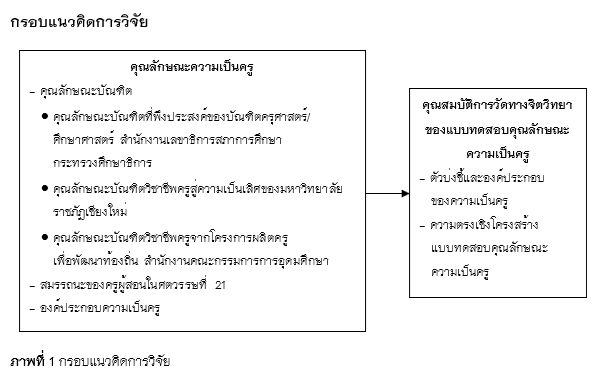The Psychometric Properties of Teacher Attributions Testing
Main Article Content
Abstract
The objectives of this study were to develop the teacher attributions indicators and factors and to verify the construct validity of the teacher attributions testing. The target group comprised 80 teachers and educational personnel, parents, students at all levels, and students under the Homeland-Stationed Teachers Program. The two-stage cluster random sampling method was applied to select the sample group, consisting of 1,000 high school students in Chiang Mai province. The research instrument was composed of a teacher attributions test. A confirmatory factor analysis was performed to examine the construct validity and the Cronbach’s Alpha Coefficient was conducted to assess the internal consistency.
The research results revealed that there were five teacher attributions indicators and factors, comprising integrity, spirituality, inquisitiveness, personality, and interpersonal relationship. The construct validity of the testing was appropriate and in line with empirical data with the Goodness of Fit and significance (
= 13.002* -274.053; p<0.00). The indicators and factors are detailed as follows: integrity (
= 121.289; p<0.01, RMSEA = 0.024, SRMR = 0.033, CFI = 0.972, and TLI = 0.971), spirituality (
= 84.572; p<0.01, RMSEA = 0.025, SRMR = 0.030, CFI = 0.979, and TLI = 0.971), inquisitiveness (
= 227.604; p<0.01, RMSEA = 0.044, SRMR = 0.039, CFI = 0.932, and TLI = 0.918), personality (
= 13.002; p<0.01, RMSEA = 0.027, SRMR = 0.019, CFI = 0.990, and TLI = 0.982), and interpersonal relationship (
= 274.053; p<0.01, RMSEA = 0.045, SRMR = 0.040, CFI = 0.922, and TLI = 0.908) respectively. The construct validity is .90.
Downloads
Article Details

This work is licensed under a Creative Commons Attribution-NonCommercial-NoDerivatives 4.0 International License.
References
กระทรวงศึกษาธิการ. (2562). มาตรฐานคุณวุฒิระดับปริญญาตรี สาขาครุศาสตร์และสาขาศึกษาศาสตร์ (หลักสูตรสี่ปี). สืบค้นจาก http://www.ratchakitcha.soc.go.th/DATA/PDF/2562/E/056/T_0012.PDF
กัญภร เอี่ยมพญา, นิวัตต์ น้อยมณี, อภิชาติ อนุกูลเวช และดาวประกาย ระโส. (2564).จิตวิญญาณครูในศตวรรษที่ 21. วารสารครุศาสตร์ปริทรรศน์, 8(2), 398-409.
กิตินันท์ โนสุ. (2557). องค์ประกอบและตัวบ่งชี้จิตวิญญาณความเป็นครู.สังกัดสำนักงานเขตพื้นที่การศึกษาประถมศึกษาในจังหวัดภาคเหนือตอนบน. วารสารการวิจัยกาสะลองคำ, 8(1), 53-65.
จักรแก้ว นามเมือง. (2560). บุคลิกภาพของครูและลักษณะการสอนที่ดี. วารสารบัณฑิตแสงโคมคำ, 2(1), 55-64.
ชนันภรณ์ อารีกุล. (2562).องค์ประกอบความเป็นครูในศตวรรษที่ 21 บนพื้นฐานของจรรยาบรรณวิชาชีพเชิงพุทธบูรณาการ.วารสารบัณฑิตศึกษาปริทรรศน์, 15(2), 153-164.
ธรรมนันทิกา แจ้งสว่าง, ดุษฎี โยเหลา, ปกรณ์ สิงห์สุริยา, และนิยะดา จิตต์จรัส. (2555). ประสบการณ์ของการเป็นครูผู้มีจิตวิญญาณความเป็นครู: การศึกษาเชิงปรากฏการณ์วิทยา. วารสารพฤติกรรมศาสตร์, 18(1), 55-65.
ธราญา จิตรชญาวณิช. (2560). การศึกษาและความเป็นครูไทย. กรุงเทพฯ: สำนักพิมพ์แห่งจุฬาลงกรณ์มหาวิทยาลัย.
นิทรา ฉิ่นไพศาล และพระครูสุจิตรัตนากร. (2559). คุณธรรมความเป็นครู. วารสารครุศาสตร์ปริทรรศน์, 3(1), 142-155.
นิวัตต์ น้อยมณี และกัญภร เอี่ยมพญา. (2560). จิตวิญญาณครู. (พิมพ์ครั้งที่ 2). กรุงเทพฯ: 21 เซนจูรี่.
ณัฐมน พันธุ์ชาตรี. (2559). การสร้างเสริมคุณลักษณะความเป็นครูของนักศึกษาคณะครุศาสตร์ มหาวิทยาลัยราชภัฏ. (วิทยานิพนธ์ปรัชญาดุษฎีบัณฑิต, สาขาวิชาการบริหารการศึกษา มหาวิทยาลัยศิลปากร).
พระมงคลธรรมวิธาน,พระครูสิริธรรมนิเทศ และประสิทธิ์ สระทอง. (2561). ครูมืออาชีพสู่การเรียนรู้แบบมืออาชีพ. Veridian E-Journal, Silpakorn University, 11(1), 2486-2499.
วัลนิกา ฉลากบาง. (2559). จิตวิญญาณความเป็นครู: คุณลักษณะสำคัญของครูมืออาชีพ. วารสารมหาวิทยาลัยนครพนม, 6(2), 23-128.
สำนักงานคณะกรรมการข้าราชการครูและบุคลากรทางการศึกษา. (2547). ครูดีผู้พัฒนาทรัพยากรมนุษย์ของชาติ (ฉบับรายละเอียด). กรุงเทพฯ: คุรุสภา.
สำนักงานเขตพื้นที่การศึกษามัธยมศึกษาเขต 34. (2563). สารสนเทศทางการศึกษา ปีการศึกษา 2563. สำนักงานคณะกรรมการการศึกษาขั้นพื้นฐาน กระทรวงศึกษาธิการ. สืบค้นจาก http://www.secondarycm.go.th/web/wpcontent/uploads/2021/05/-63-.pdf
สำนักงานคณะกรรมการการอุดมศึกษา. (2560). เกณฑ์มาตรฐานหลักสูตรระดับอุดมศึกษา พ.ศ. 2558 และเกณฑ์มาตรฐานที่เกี่ยวข้อง. กระทรวงศึกษาธิการ. สืบค้นจาก http://cid.buu.ac.th/standard/Standard%20Curr-2558-Book.pdf
สำนักงานเลขาธิการสภาการศึกษา. (2560). แผนการศึกษาแห่งชาติ พ.ศ. 2560 – 2579. สืบค้นจาก http://www.onec.go.th/index.php/page/view/Outstand/2532
สำนักงานเลขาธิการสภาการศึกษา. (2558). สภาพการจัดการศึกษาเฉพาะทางในประเทศไทย ปี 2556: การผลิตบุคลากร. กระทรวงศึกษาธิการ. สืบค้นจาก http://www.onec.go.th/th.php/book/BookView/1444
อมรรัตน์ แก่นสาร. (2558). การพัฒนาตัวบ่งชี้จิตวิญญาณความเป็นครูของครู สังกัดสำนักงานคณะกรรมการการศึกษา ขั้นพื้นฐาน. (ดุษฎีนิพนธ์ปรัชญาดุษฎีบัณฑิต, สาขาวิชาวิจัยหลักสูตรและการสอน มหาวิทยาลัยราชภัฏสกลนคร).
อมรรัตน์ แก่นสาร, วัลนิกา ฉลากบาง, วาโร เพ็งสวัสดิ์, และพรเทพ เสถียรนพเก้า. (2560). การพัฒนาตัวบ่งชี้จิตวิญญาณความเป็นครูของครูสังกัดสํานักงานคณะกรรมการการศึกษาขั้นพื้นฐาน. วารสารมหาวิทยาลัยนครพนม, 7(1), 7-17.
อรอุมา เจริญสุข. (2559). การตรวจสอบความตรงเชิงโครงสร้างของโมเดลการวัดจิตวิญญาณความเป็นครูของนิสิตหลักสูตรการศึกษาบัณฑิต (กศ.บ. 5 ปี) มหาวิทยาลัยศรีนครินทร์วิโรฒ: การวิเคราะห์กลุ่มพหุ. วารสารวิธีวิทยาการวิจัย, 29(2), 189-208.
อนุวัติ คูณแก้ว. (2561). การศึกษาคุณลักษณะของครูไทยในศตวรรษที่ 21. เพชรบูรณ์: คณะครุศาสตร์มหาวิทยาลัยราชภัฏเพชรบูรณ์.
อุไร จักษ์ตรีมงคล. (2557). การพัฒนาแบบวัดความสามารถทางวิชาชีพครูของกลุ่มวิชาชีพครู. วารสารวิจัยและพัฒนา มหาวิทยาลัยราชภัฏสวนสุนันทา, 6(1), 35-43.
Allen, M. J., and Yen, W. M. (2002). Introduction to measurement theory: Prospect heights. IL: Waveland Press.
Bhushan, V. (1974). Adaptation of an intelligence test from English to France. Journal of Education Measurement, 11(1), 43-48.
Charoenthaweesub, M & Hale, C. L. (2011(. Thai family communication patterns: Parent-adolescent communication and the Well-being of Thai families. In the First International Conference on Interdisciplinary Research and Development, Thailand. Retrieved from http://www.inrit2013.com/inrit2011/Proceedings2011/02_84_16E_Mathurada%20Charoenthaweesub_ [6].pdf
Hair, J., Anderson, R., Black, B., and Babin, B. (2016). Multivariate data analysis. Mishawaka: Pearson Education.
Koerner, A. F., & Fitzpatrick, M. A. (2006). Family communication patterns theory: A social cognitive approach. In Braithwaite D. O. & Baxter L. A. (Eds.), Engaging theories in family communication: Multiple perspectives (pp. 50–65). Thousand Oaks, CA: Sage Publications, Inc.
Livingston, S.A. (2018). Test reliability—basic concepts. Princeton, New Jersey: Educational Testing Service.
Middleton, F. (2022). The 4 types of reliability in research | definitions & examples. Scribbr. Retrieved from https://www.scribbr.com/methodology/types-of-reliability/
Rodgers, R. F., Schaefer, L. M., Thompson, J. K., Girard, M., Bertrand, M., and Chabrol, H. (2016). Psychometric properties of the Sociocultural Attitudes Towards Appearance Questionnaire-4 (SATAQ-4) in French women and men. Body Image, 17, 143-151.
Schumacker, R. E., & Lomax, R. G. (1996). A beginner's guide to structural equation modeling. New Jersey: Lawrence Erlbaum Associates, Inc.
Yamamiya, Y., Shimai, S., Schaefer, L. M., Thompson, J. K., Shroff, H., Sharma, R., and Ordaz, D.L. (2016). Psychometric properties and validation of the Sociocultural Attitudes Towards Appearance Questionnaire-4 (SATAQ-4) with a sample of Japanese adolescent girls. Body Image, 19(1), 89-97.


